Artificial intelligence feels like an abstract concept for many in healthcare. Its true impact on medical displays seems unclear, causing hesitation among clinical and IT leaders. This uncertainty slows down the adoption of powerful new tools.
The medical display industry is moving from caution to active integration of AI. Leaders now recognize its potential to enhance image quality, automate quality assurance, and create smarter diagnostic and surgical workflows.
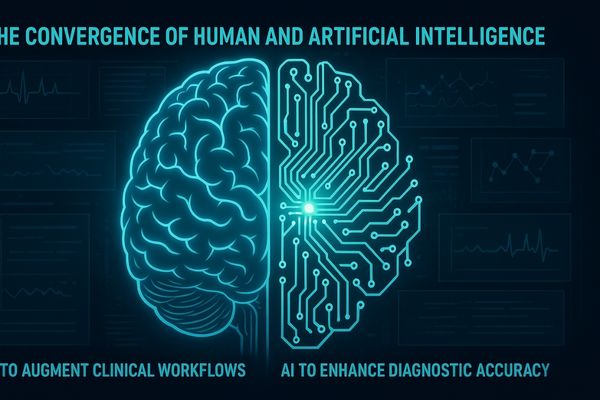
The conversation around AI in medicine has matured significantly. It is no longer a question of if AI will be integrated into imaging devices, but how it can be done responsibly and effectively. This evolution marks a pivotal change, turning passive viewing screens into active clinical tools.
Growing Acceptance of AI in Medical Imaging Workflows
Radiologists face ever-increasing workloads, leading to fatigue and potential diagnostic oversights. This pressure demands tools that can improve efficiency without sacrificing accuracy. AI is emerging as a critical ally in this challenge.
The medical display industry now widely recognizes AI’s value in image analysis and diagnostic support. This technology is seen as a key to boosting radiologist efficiency and reducing human error.

The initial view of AI was as a standalone software tool, separate from the display hardware. This perspective is now changing. We see a growing trend toward integrating AI capabilities closer to the point of care, directly within the imaging ecosystem. For instance, AI algorithms1 can pre-screen imaging studies and flag suspicious findings for urgent review. This triage function helps radiologists prioritize their worklists, focusing on critical cases first. The display’s role in this new workflow is to render these AI-generated overlays with absolute clarity and precision. It must ensure that the highlighted regions are perfectly aligned and visually distinct from the underlying image data. A monitor like the MD22CA – 2MP Diagnostic Monitor2 provides the sharpness and consistent brightness needed to make these AI-driven insights immediately apparent, helping clinicians make faster, more informed decisions.
AI-Driven Enhancements Reshape Display Performance Standards
A traditional medical display is a passive device. It simply shows the image data it receives from the source. This static approach means the display cannot adapt to changing content or viewing conditions, limiting its potential.
AI is transforming displays from passive presenters into active optimizers. It can automatically adjust brightness, contrast, and color based on the specific modality or clinical scenario being viewed.
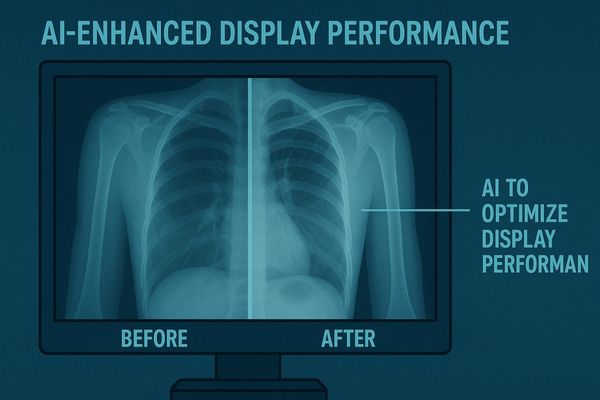
The concept of an "intelligent display3" is moving from theory to reality. AI is enabling monitors to perform active image optimization. An AI-enhanced display4 can recognize the type of image being presented, such as a CT scan, an MRI, or an endoscopic video feed. It then automatically applies a preset or dynamically adjusts its performance characteristics to optimize the view for that specific task. This goes far beyond a simple ambient light sensor. The AI can sharpen subtle details in a grayscale image or enhance the vibrancy of color in a surgical view. This active partnership between the display and the imaging software improves diagnostic visibility and reduces the need for manual adjustments, allowing clinicians to work more efficiently. Our MD85CA – 8MP Multi-modality Diagnostic Monitor is built for these demanding environments, and integrating AI will further enhance its ability to provide tailored views across different imaging types.
| Feature | Traditional Display | AI-Enhanced Display |
|---|---|---|
| Image Settings | Manual or fixed presets | Automatic, content-aware adjustment |
| Workflow | Clinician adjusts display per study | Display adapts to clinician’s workflow |
| Performance | Static | Dynamic and optimized |
Industry Leaders Explore AI for Automated Calibration and QA
All displays degrade over time, causing color and brightness to drift. Manual calibration is time-consuming and often deferred, creating a risk of non-compliant displays being used for diagnosis. This is a significant maintenance burden.
Leading manufacturers are now developing AI-powered automatic calibration and real-time quality assurance. These features aim to eliminate manual maintenance, reduce costs, and ensure unwavering diagnostic consistency.
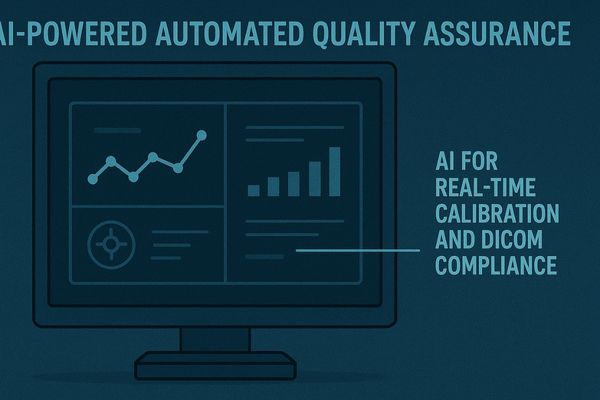
Maintaining DICOM compliance[^5] across a fleet of diagnostic displays is a major challenge for hospital IT departments. Traditional quality assurance (QA) involves periodic checks with external sensors, a process that is both labor-intensive and provides only a snapshot in time. AI offers a more intelligent solution. By embedding AI with an internal sensor, a display can perform continuous self-monitoring and real-time QA. The AI can analyze usage patterns, temperature fluctuations, and backlight aging to predict when performance might drift out of compliance. It can then trigger an automatic calibration to correct the issue before it impacts diagnostic quality. This predictive and proactive approach ensures the display is always operating at its peak performance. Our MD120C – 12MP High-Precision Diagnostic Monitor with AI Calibration5 embodies this principle, using intelligent systems to guarantee long-term stability and reliability with minimal human effort.
Concerns Over Reliability and Regulatory Compliance Persist
The power of AI also brings new anxieties. Many clinicians are wary of "black box" algorithms, where the reasoning behind a suggestion is not clear. This lack of transparency creates a barrier to trust, especially when patient safety is on the line.
Despite the enthusiasm, significant concerns about AI’s reliability, algorithmic transparency, and the complex path to regulatory approval remain. These issues are particularly acute in high-stakes diagnostic environments.
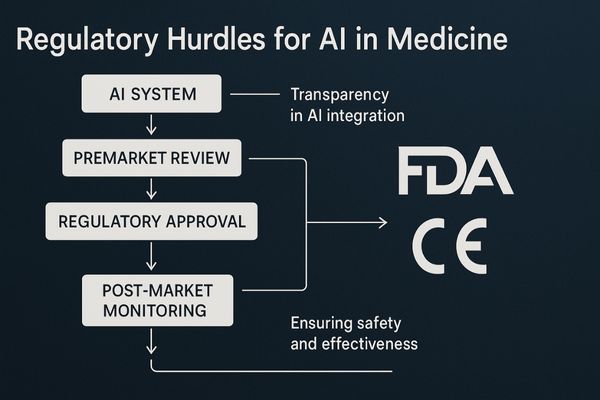
The medical industry rightly holds new technologies to the highest standards. Before AI can be fully integrated into a device like a medical display, it must be proven safe, reliable, and effective. The "black box" problem is a primary concern. To address it, the field is moving toward Explainable AI (XAI)6, which aims to make algorithmic decision-making understandable to the user. Another major hurdle is regulation. When AI software performs a diagnostic function, it can be classified as Software as a Medical Device (SaMD)7, requiring rigorous validation and clearance from bodies like the FDA or CE. For these reasons, the industry is taking a measured approach. The initial focus is on using AI to assist clinicians, not replace them. A display such as the MD32C – 3MP Diagnostic Monitor, a reliable workhorse for general radiology, represents the standard of trust that AI systems must meet and exceed.
| AI Concern | Industry Response / Solution |
|---|---|
| "Black Box" Algorithms | Development of Explainable AI (XAI) to show reasoning. |
| Reliability & Accuracy | Extensive clinical validation with large, diverse datasets. |
| Regulatory Hurdles | Clear documentation and adherence to SaMD guidelines (e.g., FDA, MDR). |
| Clinician Trust | "Human-in-the-loop" systems that assist, not replace, the expert. |
AI Integration Signals Future Direction of Medical Displays
For decades, we have thought of medical displays as simple output devices. This hardware-centric view is quickly becoming outdated. The future of medical imaging demands a more integrated and intelligent approach.
As AI becomes deeply embedded throughout the medical imaging ecosystem, displays will evolve from hardware-centric devices into fully integrated, intelligent solutions that actively participate in the diagnostic process.
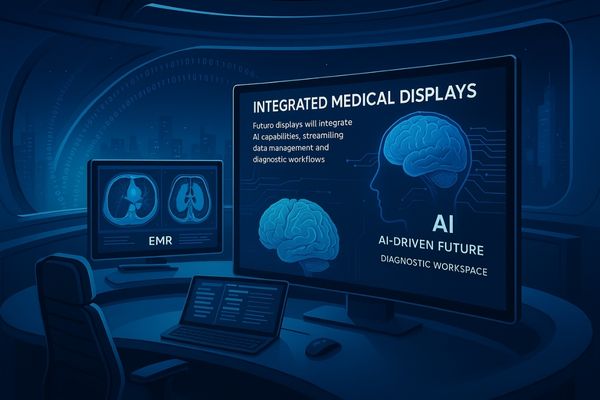
We are on the verge of a paradigm shift. The medical display of the future will not be a standalone peripheral. It will be a central hub in a clinician’s digital workspace—an intelligent imaging platform8. This platform will integrate seamlessly with PACS, AI analysis software, and the electronic medical record (EMR). Imagine a display that uses AI to learn a radiologist’s reading habits and automatically arranges images according to their preferred hanging protocol. This same display could highlight relevant findings from the EMR directly alongside the corresponding image. This evolution transforms the monitor from a passive screen into an active assistant that anticipates needs and streamlines workflow. A large-format display9 like the MD45C – Dual-screen Diagnostic Monitor (Single Panel) is a step in this direction, providing the digital canvas required to manage and display these multiple, interwoven data streams effectively.
Conclusion
The integration of artificial intelligence is fundamentally reshaping medical displays. They are evolving from passive screens into intelligent partners that enhance diagnostic accuracy, efficiency, and consistency in clinical practice.
📩 Interested in exploring AI-enhanced medical displays for your facility? Reach out to Martin at martin@reshinmonitors.com for expert recommendations and tailored solutions from Reshin.
-
Explore how AI algorithms enhance medical imaging by improving accuracy and efficiency in diagnostics. ↩
-
Learn about the essential features of a 2MP Diagnostic Monitor to ensure optimal performance in clinical settings. ↩
-
Explore this link to understand how intelligent displays are revolutionizing imaging technology and enhancing diagnostic capabilities. ↩
-
Discover the advantages of AI-enhanced displays in medical imaging, including improved visibility and efficiency for clinicians. ↩
-
Exploring AI calibration can reveal innovative methods to enhance display accuracy and reliability, vital for effective diagnostics. ↩
-
Explore this link to understand how XAI enhances transparency in AI decision-making, crucial for trust in medical applications. ↩
-
This resource will provide insights into the regulatory landscape for SaMD, essential for ensuring safety and efficacy in medical AI. ↩
-
Explore this link to understand how intelligent imaging platforms are revolutionizing healthcare and improving clinician workflows. ↩
-
Discover the advantages of large-format displays in medical imaging and how they enhance diagnostic accuracy and efficiency. ↩


